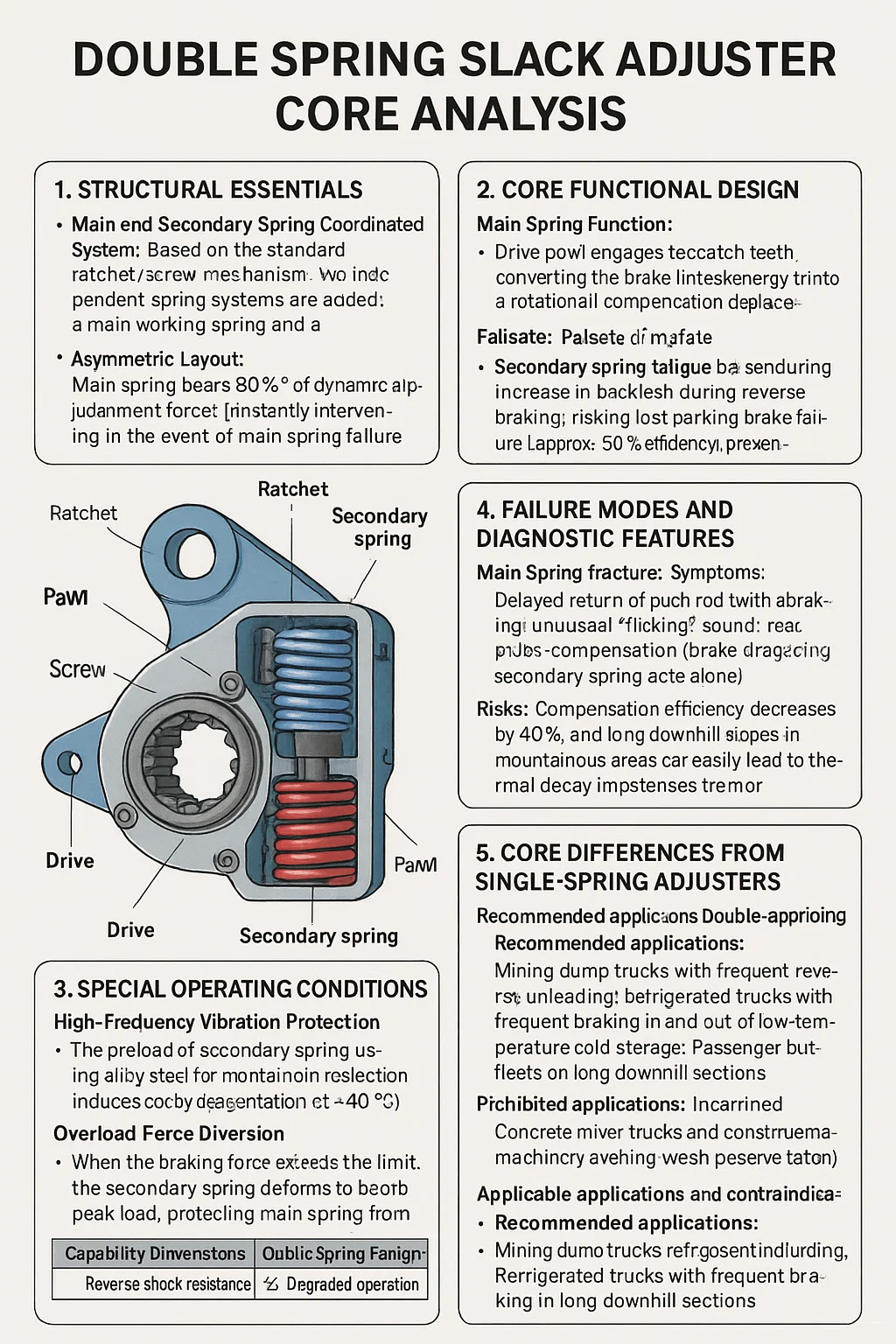 (+86)-137 5851 1881
(+86)-137 5851 1881

Double Spring Slack Adjuster Core Analysis
1. Structural Essentials
Main and Secondary Spring Coordinated System: Based on the standard ratchet/screw mechanism, two independent spring systems are added: a main working spring and a secondary safety spring.
Asymmetric Layout: The main spring bears 90% of the dynamic adjustment force; the secondary spring is only pre-compressed and on standby, instantly intervening in the event of main spring failure.
2. Core Functional Design
Main Spring Function:
The drive pawl engages the ratchet teeth, converting the brake release kinetic energy into a rotational compensation displacement of the screw.
Provides constant contact pressure, ensuring precise return to the original position after each braking operation.
Secondary Spring Function:
Anti-reverse lock: Prevents the ratchet from reversing during sudden reverse impact (such as sudden braking in reverse), which could lead to uncontrolled increase in slack.
Failsafe: If the main spring breaks, the secondary spring immediately takes over to maintain minimum compensation (approximately 50% efficiency), preventing instantaneous brake failure.
3. Special Operating Conditions
High-Frequency Vibration Protection:
The preload of the secondary spring suppresses abnormal tremor of the pawl on bumpy roads, eliminating "false compensation" (brake drag caused by over-tightening).
Low-Temperature Tolerance Design:
The main spring utilizes low-temperature toughness alloy steel, and the secondary spring utilizes embrittlement-resistant stainless steel, ensuring coordinated operation even at -40°C.
Overload Force Diversion:
When the braking force exceeds the limit, the secondary spring deforms to absorb the peak load, protecting the main spring from plastic deformation.
4. Failure Modes and Diagnostic Features
Main Spring Fracture:
Symptoms: Delayed return of the push rod after braking, accompanied by an unusual "clicking" sound (the pawl colliding when the secondary spring acts alone).
Risks: Compensation efficiency decreases by 40%, and long downhill slopes in mountainous areas can easily lead to thermal decay.
Secondary Spring Fatigue:
Symptoms: Sudden increase in backlash during reverse braking (failure of the reverse lock).
High-Risk Scenario: Loss of parking brake capability when starting on a slope with a heavily loaded trailer. Double-spring synchronization jam:
Cause: Low-quality grease carbonizes and adheres to the spring coils during high temperatures.
Consequence: The adjuster is completely locked, and manual reset is ineffective.
5. Core Differences from Single-Spring Adjusters
| Capability Dimension | Single Spring Adjuster | Double Spring Adjuster |
| Reverse Impact Resistance | Prone to ratchet back-jumping | Secondary spring rigidly locks mechanism |
| Function After Spring Fail | Complete adjustment failure | Graceful degradation (backup spring engagement) |
| High-Freq Vibration Stability | Vibration-induced over-adjustment | Dual-spring damping prevents hunting |
| Low-Temperature Reliability | Primary spring cold brittleness risk | Redundant design with cryogenic materials |
6. Applicable Applications and Contraindications
Recommended Applications:
Mining dump trucks with frequent reverse unloading; Refrigerated trucks with frequent braking in and out of low-temperature cold storage; Passenger bus fleets on long downhill sections
Prohibited Applications:
Concrete mixer trucks (mortar intrusion can cause rusting of double-spring synchronization); Construction machinery being washed with high-pressure water jets (moisture penetration can induce electrolytic corrosion between springs)
